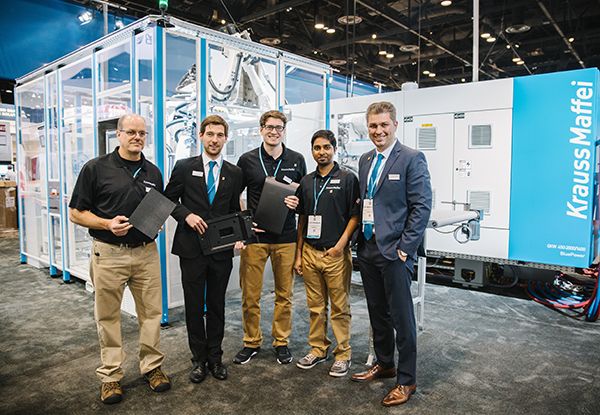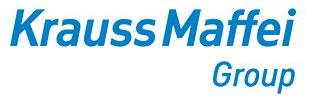The FiberForm process demonstrates KraussMaffei’s dedication to bringing thermoplastic lightweight construction to the next level and establishing it successfully in series production.
At NPE in Orlando, USA (May 7 to 11), KraussMaffei presented for the first time a FiberForm application in connection with SpinForm technology for multi-component injection moulding. The combination of soft and hard components together with the high strength of the components, results in completely new potential applications — and not just for vehicle construction.
New design options and weight reduction
The FiberForm process developed by KraussMaffei combines organic sheet thermoforming and injection moulding into a single process. The result is fiber-reinforced plastic components that are incredibly lightweight considering their strength, making them ideal for automotive applications. “Our groundbreaking FiberForm system is second to none when it comes to lightweight production using fiber-reinforced plastic components. Our customers appreciate the high quality, reliability and cost-efficiency when manufacturing fiber-reinforced lightweight components in large quantities and fast cycle times,” explains Paul Caprio, President of the KraussMaffei Corporation.
The FiberForm process can also be joined efficiently with multi-component injection moulding, as KraussMaffei demonstrated effectively at the NPE trade show booth. At the show, a GXW 450-2000/1400 SpinForm with swivel plate technology was producing a centre armrest for the vehicle interior. A continuous-fiber-reinforced organic sheet with a 1 mm thick, continuous-fiber-reinforced composite sheet was first encapsulated with polypropylene (PP) and then overpacked directly with a thermoplastic elastomer (TPE). “This combination can be used to create completely new visual and haptic component features for thermoplastic composites in a single process. Thanks to the TPE component, the centre armrest produced at NPE has functional parts and visible parts with surfaces that are extremely soft and visually appealing, which increases comfort and visual aesthetics in the vehicle interior,” says Caprio. In turn, the use of the composite sheet increases the rigidity and strength of the component. This means that the reinforcing ribs and component itself are made with thinner walls, which reduces their weight. KraussMaffei sees great potential for the combination of FiberForm and multicomponent technology in applications such as vehicle manufacturing for semi-structural lightweight components in the interior or between the passenger compartment and the engine bay.
SpinForm swivel plate technology excels
High quantities are one of the strengths of the FiberForm technology. Therefore, KraussMaffei consciously chose the SpinForm swivel plate technology. It offers numerous advantages compared to other technologies such as the rotary table, index plate and sliding table. Using two mould parting lines provides twice the number of cavities with the same clamping force. This increases cost-efficiency. Because rotation takes place between the vertical bar pair, the SpinForm technology offers a great deal of space, even for large moulds. This makes it ideal for producing large-format components or multiple components. Furthermore, APC plus allows for the integration of special processes such as compression moulding.
Intelligent automation solution supports short cycle times
Multicomponent technology normally takes up more cycle time. Therefore, KraussMaffei specifically chooses cost-effective swivel plate technology and combines it with intelligent automation solutions and heating technology that is optimally adapted to the injection moulding process. “This enables us to attain cycle times of under 60 seconds,” says Dr Mesut Cetin, Product and Project Manager for Lightweight Construction at KraussMaffei Automation.
The composite sheet is initially transferred to the production cell via a simple drawer system. Optical inspection of the organic sheet ensures transfer to the mould with position accuracy. This ensures that only semi-finished products that are free of defects are forwarded to the IR 600 R3000 K/S industrial robot and picked up by the robot, in the same manner, each time. Then, the organic sheet is heated up on both sides in the infrared heating station and transferred vertically to the mould system. “The infrared heating station is located directly above the mould parting line. This allows the transfer time to be reduced even further and minimises the overall cycle time,” Cetin explains.
Now, in the first cycle step, on the one side of the swivel plate, the basic components of the centre armrest are manufactured with the injection moulding unit (top and bottom shell). The top shell is created by encapsulating the organic sheet with PP, while the bottom shell is primary-cast out of pure PP. For the second cycle step, the swivel plate rotates and the components are flow-coated with TPE with the second injection moulding unit. While the top shell (visible and functional surface) is flow-coated with TPE, the bottom shell is flow-coated in spots. The component demoulding (top and bottom shell) then takes place using the second industrial robot, an IR 600 R2030 F/K. “The heating of the composite sheets and the demoulding of the components take place in parallel, and the individual process steps are thus decoupled from one another. This, in turns, saves valuable cycle time,” says Cetin.
Seamless traceability of process data
Another highlight of the GXW 450 FiberForm at the NPE was the DataXplorer, an open system from KraussMaffei integrated into the MC6 control system that continuously detects up to 500 signals at the machine. Like an airplane’s black box, DataXplorer thus provides information about all important system and process data. Unlike Euromap 63 and the actual value report of a machine, this happens continuously — that is, in the curve progression, and not as a discrete value in a discrete moment. “The curves provide customised key figures that enable in-depth process analyses and documentation to be carried out. This is particularly advantageous for safety-related components,” says Cetin.
At the NPE, KraussMaffei was providing a demonstration of the thoroughness with which production data can be collected and traced using the FiberForm technology. An individualised QR code on the centre armrest manufactured on site guided the owners of smartphones to the specific report for their article. Here, it was possible to find out the melt pressure and screw position in addition to, for example, the heat-up time of the composite sheet and its transfer time from the heating station to the injection mould. In addition, the curves of the various heating zones of the infrared heating station were recorded.
Part of the KraussMaffei Plastics 4.0 family
The DataXplorer is part of the Plastics 4.0 solutions that KraussMaffei uses to support its customers in implementing the potential and benefiting from the opportunities arising from Industry 4.0. Plastics 4.0 focuses on the digitalisation and networking of the global production processes with the goal of higher production efficiency, flexibility, automation, availability and quality. The range of Plastics 4.0 products by KraussMaffei includes everything from self-optimising intelligent machines and functions to uninterrupted analysis and networking of various components of the production process and a variety of global services.

